Business Law Assignment: Postal Rule, Electronic Transactions Act
VerifiedAdded on 2020/05/16
|10
|2432
|67
Report
AI Summary
This report delves into the intricacies of the postal rule within the realm of business and company law, examining its historical context and evolution. It begins by outlining the postal rule's significance in contract law, particularly concerning offer and acceptance, and then traces its development through key legal cases like Adam v. Lindsbell and Henthorn v. Fraser. The report further analyzes the impact of electronic transactions and modern communication methods, such as email, on the application of the postal rule. It discusses the Electronic Transactions Act and its provisions, including the concept of instantaneous communication and the challenges posed by email communication. The report also explores the decline of traditional postal rule principles with the advent of instantaneous communication, contrasting contracts formed through websites and email, and examining the application of the receipt rule in internet-based contracts. It concludes by asserting that while the postal rule remains relevant, courts are increasingly hesitant to apply it in contexts involving electronic or instantaneous communication, highlighting the need for clear legal provisions in this evolving landscape.
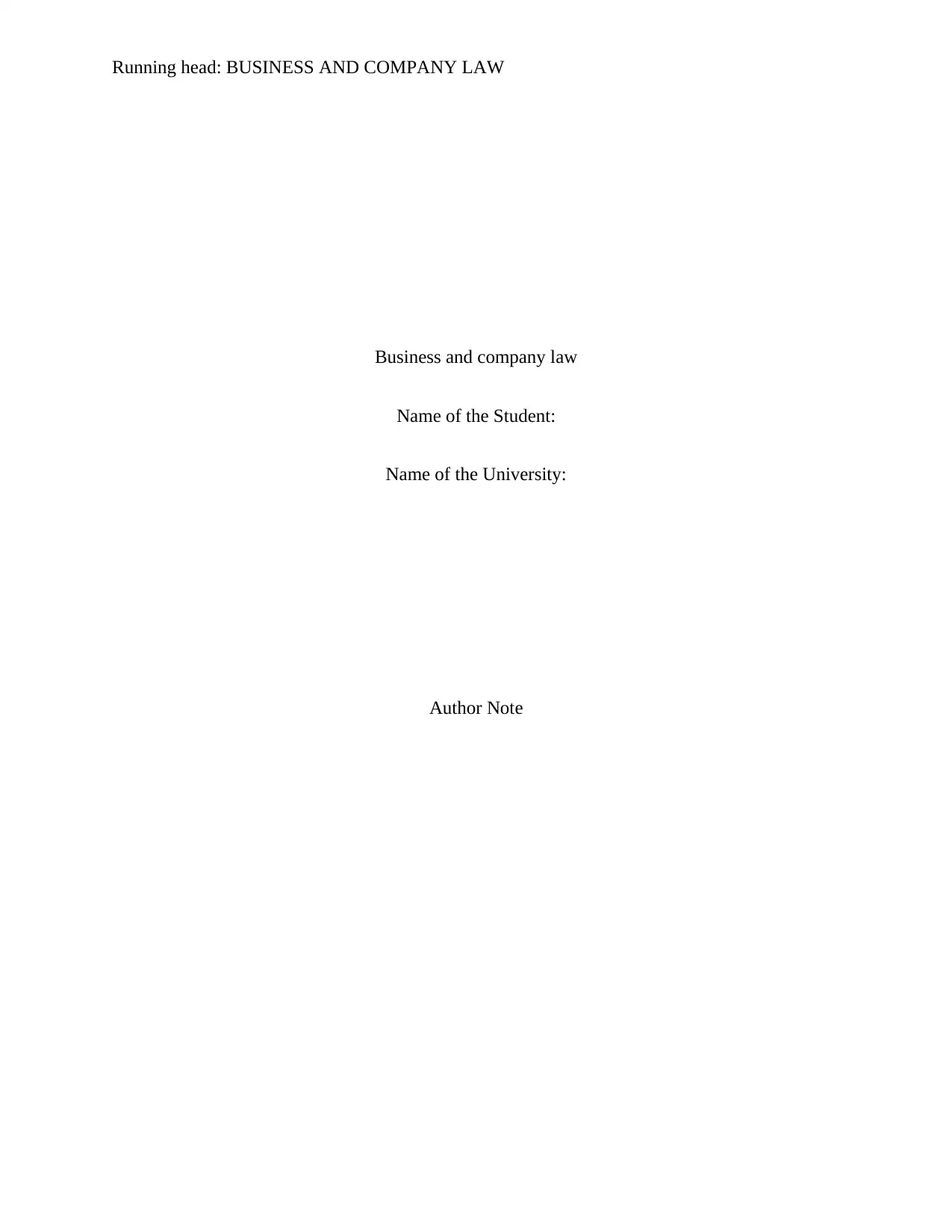
Running head: BUSINESS AND COMPANY LAW
Business and company law
Name of the Student:
Name of the University:
Author Note
Business and company law
Name of the Student:
Name of the University:
Author Note
Paraphrase This Document
Need a fresh take? Get an instant paraphrase of this document with our AI Paraphraser
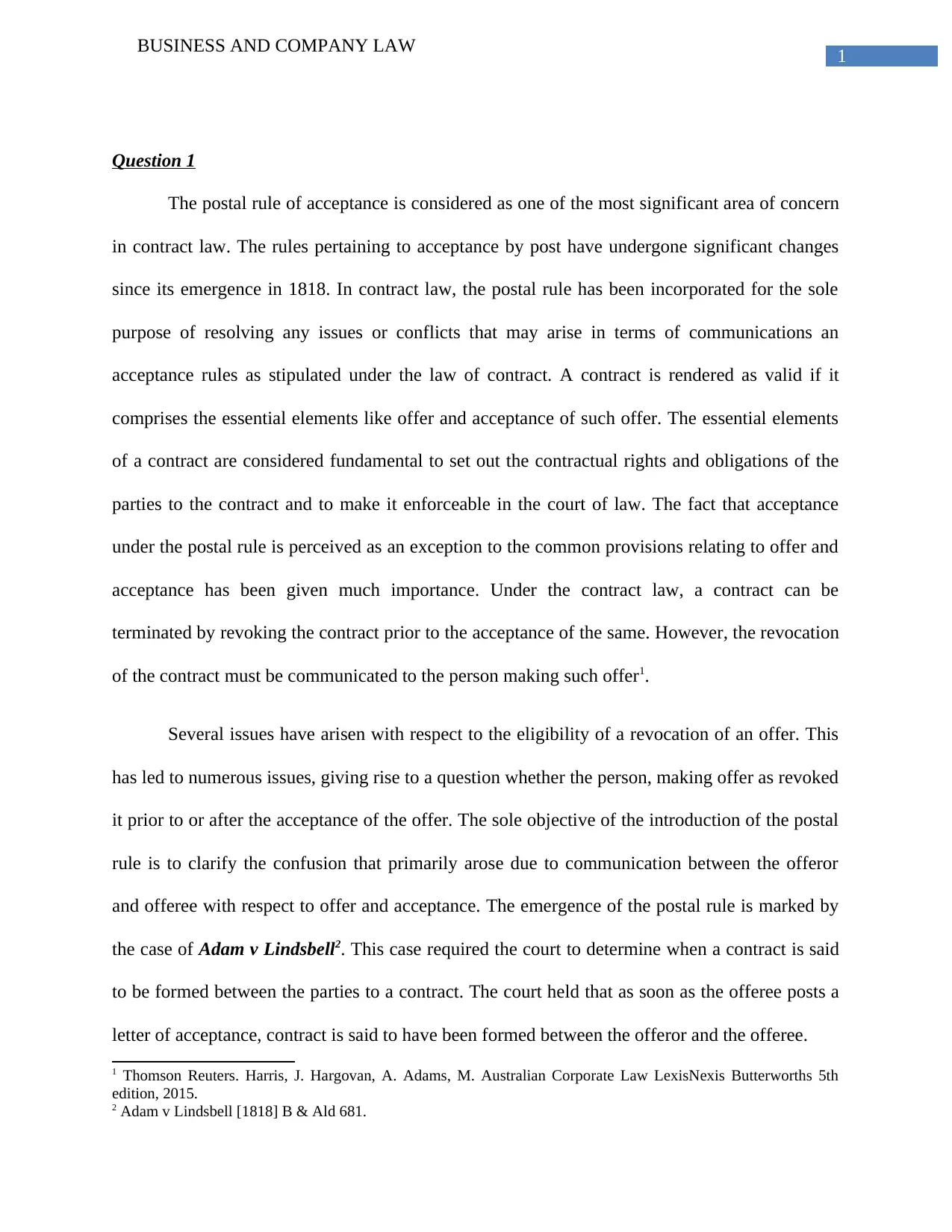
1
BUSINESS AND COMPANY LAW
Question 1
The postal rule of acceptance is considered as one of the most significant area of concern
in contract law. The rules pertaining to acceptance by post have undergone significant changes
since its emergence in 1818. In contract law, the postal rule has been incorporated for the sole
purpose of resolving any issues or conflicts that may arise in terms of communications an
acceptance rules as stipulated under the law of contract. A contract is rendered as valid if it
comprises the essential elements like offer and acceptance of such offer. The essential elements
of a contract are considered fundamental to set out the contractual rights and obligations of the
parties to the contract and to make it enforceable in the court of law. The fact that acceptance
under the postal rule is perceived as an exception to the common provisions relating to offer and
acceptance has been given much importance. Under the contract law, a contract can be
terminated by revoking the contract prior to the acceptance of the same. However, the revocation
of the contract must be communicated to the person making such offer1.
Several issues have arisen with respect to the eligibility of a revocation of an offer. This
has led to numerous issues, giving rise to a question whether the person, making offer as revoked
it prior to or after the acceptance of the offer. The sole objective of the introduction of the postal
rule is to clarify the confusion that primarily arose due to communication between the offeror
and offeree with respect to offer and acceptance. The emergence of the postal rule is marked by
the case of Adam v Lindsbell2. This case required the court to determine when a contract is said
to be formed between the parties to a contract. The court held that as soon as the offeree posts a
letter of acceptance, contract is said to have been formed between the offeror and the offeree.
1 Thomson Reuters. Harris, J. Hargovan, A. Adams, M. Australian Corporate Law LexisNexis Butterworths 5th
edition, 2015.
2 Adam v Lindsbell [1818] B & Ald 681.
BUSINESS AND COMPANY LAW
Question 1
The postal rule of acceptance is considered as one of the most significant area of concern
in contract law. The rules pertaining to acceptance by post have undergone significant changes
since its emergence in 1818. In contract law, the postal rule has been incorporated for the sole
purpose of resolving any issues or conflicts that may arise in terms of communications an
acceptance rules as stipulated under the law of contract. A contract is rendered as valid if it
comprises the essential elements like offer and acceptance of such offer. The essential elements
of a contract are considered fundamental to set out the contractual rights and obligations of the
parties to the contract and to make it enforceable in the court of law. The fact that acceptance
under the postal rule is perceived as an exception to the common provisions relating to offer and
acceptance has been given much importance. Under the contract law, a contract can be
terminated by revoking the contract prior to the acceptance of the same. However, the revocation
of the contract must be communicated to the person making such offer1.
Several issues have arisen with respect to the eligibility of a revocation of an offer. This
has led to numerous issues, giving rise to a question whether the person, making offer as revoked
it prior to or after the acceptance of the offer. The sole objective of the introduction of the postal
rule is to clarify the confusion that primarily arose due to communication between the offeror
and offeree with respect to offer and acceptance. The emergence of the postal rule is marked by
the case of Adam v Lindsbell2. This case required the court to determine when a contract is said
to be formed between the parties to a contract. The court held that as soon as the offeree posts a
letter of acceptance, contract is said to have been formed between the offeror and the offeree.
1 Thomson Reuters. Harris, J. Hargovan, A. Adams, M. Australian Corporate Law LexisNexis Butterworths 5th
edition, 2015.
2 Adam v Lindsbell [1818] B & Ald 681.
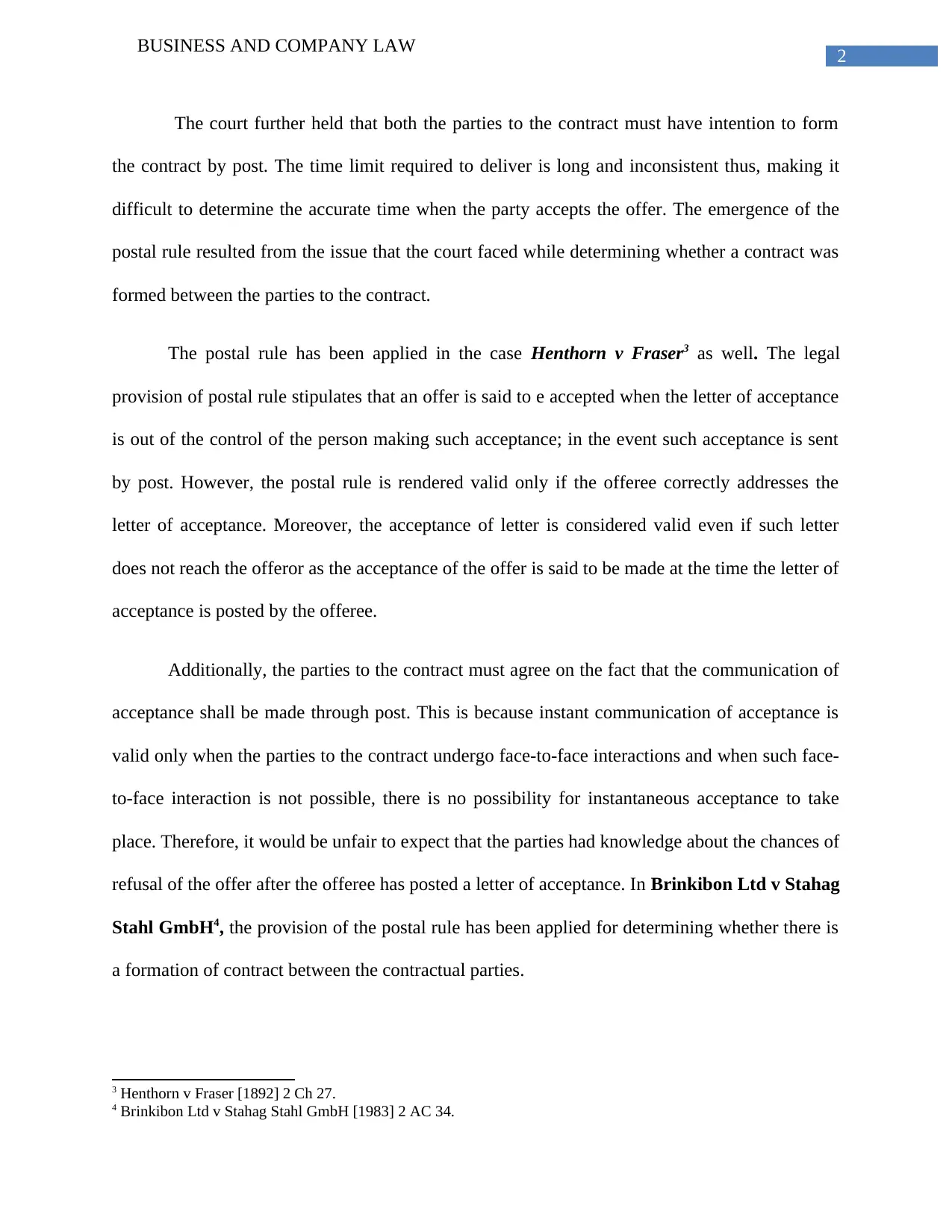
2
BUSINESS AND COMPANY LAW
The court further held that both the parties to the contract must have intention to form
the contract by post. The time limit required to deliver is long and inconsistent thus, making it
difficult to determine the accurate time when the party accepts the offer. The emergence of the
postal rule resulted from the issue that the court faced while determining whether a contract was
formed between the parties to the contract.
The postal rule has been applied in the case Henthorn v Fraser3 as well. The legal
provision of postal rule stipulates that an offer is said to e accepted when the letter of acceptance
is out of the control of the person making such acceptance; in the event such acceptance is sent
by post. However, the postal rule is rendered valid only if the offeree correctly addresses the
letter of acceptance. Moreover, the acceptance of letter is considered valid even if such letter
does not reach the offeror as the acceptance of the offer is said to be made at the time the letter of
acceptance is posted by the offeree.
Additionally, the parties to the contract must agree on the fact that the communication of
acceptance shall be made through post. This is because instant communication of acceptance is
valid only when the parties to the contract undergo face-to-face interactions and when such face-
to-face interaction is not possible, there is no possibility for instantaneous acceptance to take
place. Therefore, it would be unfair to expect that the parties had knowledge about the chances of
refusal of the offer after the offeree has posted a letter of acceptance. In Brinkibon Ltd v Stahag
Stahl GmbH4, the provision of the postal rule has been applied for determining whether there is
a formation of contract between the contractual parties.
3 Henthorn v Fraser [1892] 2 Ch 27.
4 Brinkibon Ltd v Stahag Stahl GmbH [1983] 2 AC 34.
BUSINESS AND COMPANY LAW
The court further held that both the parties to the contract must have intention to form
the contract by post. The time limit required to deliver is long and inconsistent thus, making it
difficult to determine the accurate time when the party accepts the offer. The emergence of the
postal rule resulted from the issue that the court faced while determining whether a contract was
formed between the parties to the contract.
The postal rule has been applied in the case Henthorn v Fraser3 as well. The legal
provision of postal rule stipulates that an offer is said to e accepted when the letter of acceptance
is out of the control of the person making such acceptance; in the event such acceptance is sent
by post. However, the postal rule is rendered valid only if the offeree correctly addresses the
letter of acceptance. Moreover, the acceptance of letter is considered valid even if such letter
does not reach the offeror as the acceptance of the offer is said to be made at the time the letter of
acceptance is posted by the offeree.
Additionally, the parties to the contract must agree on the fact that the communication of
acceptance shall be made through post. This is because instant communication of acceptance is
valid only when the parties to the contract undergo face-to-face interactions and when such face-
to-face interaction is not possible, there is no possibility for instantaneous acceptance to take
place. Therefore, it would be unfair to expect that the parties had knowledge about the chances of
refusal of the offer after the offeree has posted a letter of acceptance. In Brinkibon Ltd v Stahag
Stahl GmbH4, the provision of the postal rule has been applied for determining whether there is
a formation of contract between the contractual parties.
3 Henthorn v Fraser [1892] 2 Ch 27.
4 Brinkibon Ltd v Stahag Stahl GmbH [1983] 2 AC 34.
⊘ This is a preview!⊘
Do you want full access?
Subscribe today to unlock all pages.

Trusted by 1+ million students worldwide
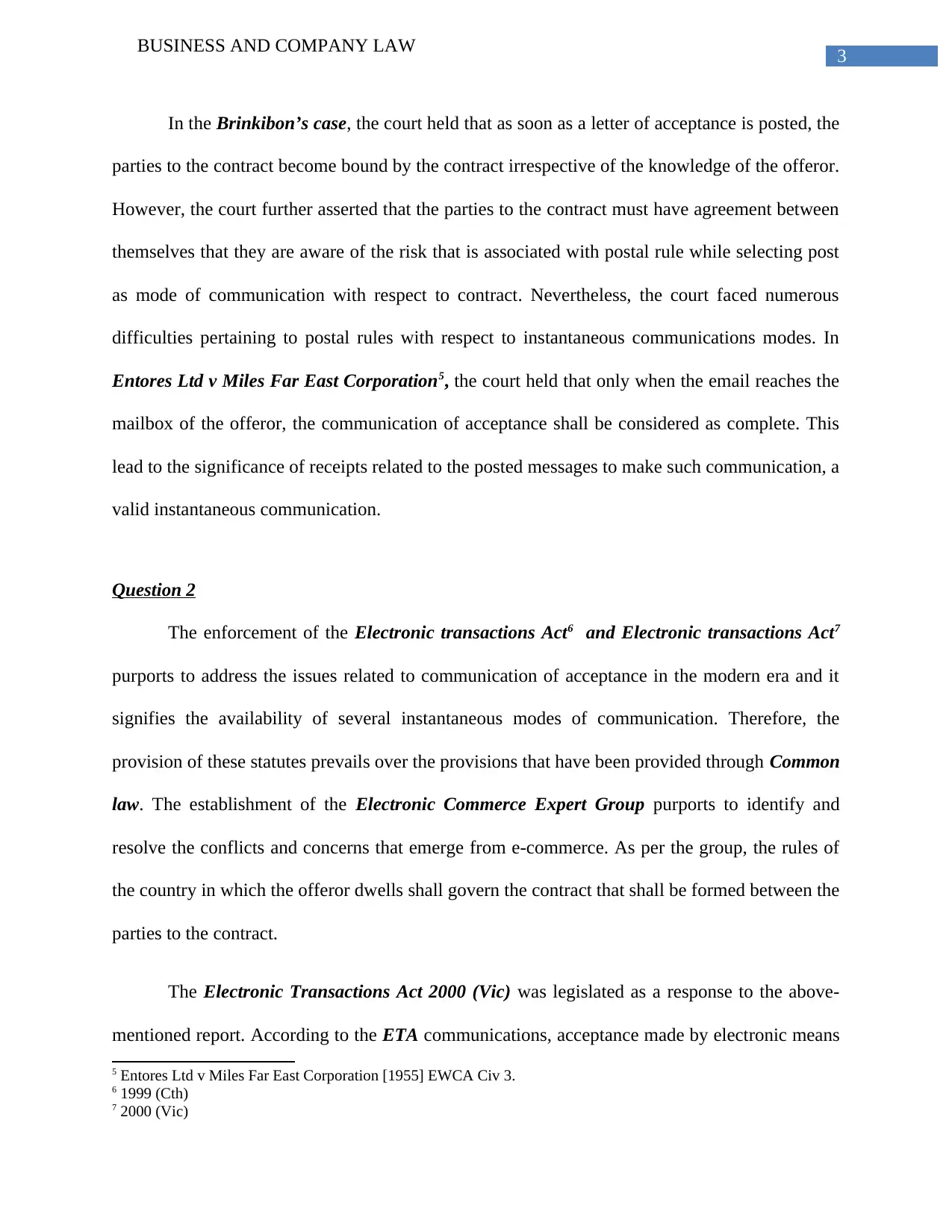
3
BUSINESS AND COMPANY LAW
In the Brinkibon’s case, the court held that as soon as a letter of acceptance is posted, the
parties to the contract become bound by the contract irrespective of the knowledge of the offeror.
However, the court further asserted that the parties to the contract must have agreement between
themselves that they are aware of the risk that is associated with postal rule while selecting post
as mode of communication with respect to contract. Nevertheless, the court faced numerous
difficulties pertaining to postal rules with respect to instantaneous communications modes. In
Entores Ltd v Miles Far East Corporation5, the court held that only when the email reaches the
mailbox of the offeror, the communication of acceptance shall be considered as complete. This
lead to the significance of receipts related to the posted messages to make such communication, a
valid instantaneous communication.
Question 2
The enforcement of the Electronic transactions Act6 and Electronic transactions Act7
purports to address the issues related to communication of acceptance in the modern era and it
signifies the availability of several instantaneous modes of communication. Therefore, the
provision of these statutes prevails over the provisions that have been provided through Common
law. The establishment of the Electronic Commerce Expert Group purports to identify and
resolve the conflicts and concerns that emerge from e-commerce. As per the group, the rules of
the country in which the offeror dwells shall govern the contract that shall be formed between the
parties to the contract.
The Electronic Transactions Act 2000 (Vic) was legislated as a response to the above-
mentioned report. According to the ETA communications, acceptance made by electronic means
5 Entores Ltd v Miles Far East Corporation [1955] EWCA Civ 3.
6 1999 (Cth)
7 2000 (Vic)
BUSINESS AND COMPANY LAW
In the Brinkibon’s case, the court held that as soon as a letter of acceptance is posted, the
parties to the contract become bound by the contract irrespective of the knowledge of the offeror.
However, the court further asserted that the parties to the contract must have agreement between
themselves that they are aware of the risk that is associated with postal rule while selecting post
as mode of communication with respect to contract. Nevertheless, the court faced numerous
difficulties pertaining to postal rules with respect to instantaneous communications modes. In
Entores Ltd v Miles Far East Corporation5, the court held that only when the email reaches the
mailbox of the offeror, the communication of acceptance shall be considered as complete. This
lead to the significance of receipts related to the posted messages to make such communication, a
valid instantaneous communication.
Question 2
The enforcement of the Electronic transactions Act6 and Electronic transactions Act7
purports to address the issues related to communication of acceptance in the modern era and it
signifies the availability of several instantaneous modes of communication. Therefore, the
provision of these statutes prevails over the provisions that have been provided through Common
law. The establishment of the Electronic Commerce Expert Group purports to identify and
resolve the conflicts and concerns that emerge from e-commerce. As per the group, the rules of
the country in which the offeror dwells shall govern the contract that shall be formed between the
parties to the contract.
The Electronic Transactions Act 2000 (Vic) was legislated as a response to the above-
mentioned report. According to the ETA communications, acceptance made by electronic means
5 Entores Ltd v Miles Far East Corporation [1955] EWCA Civ 3.
6 1999 (Cth)
7 2000 (Vic)
Paraphrase This Document
Need a fresh take? Get an instant paraphrase of this document with our AI Paraphraser
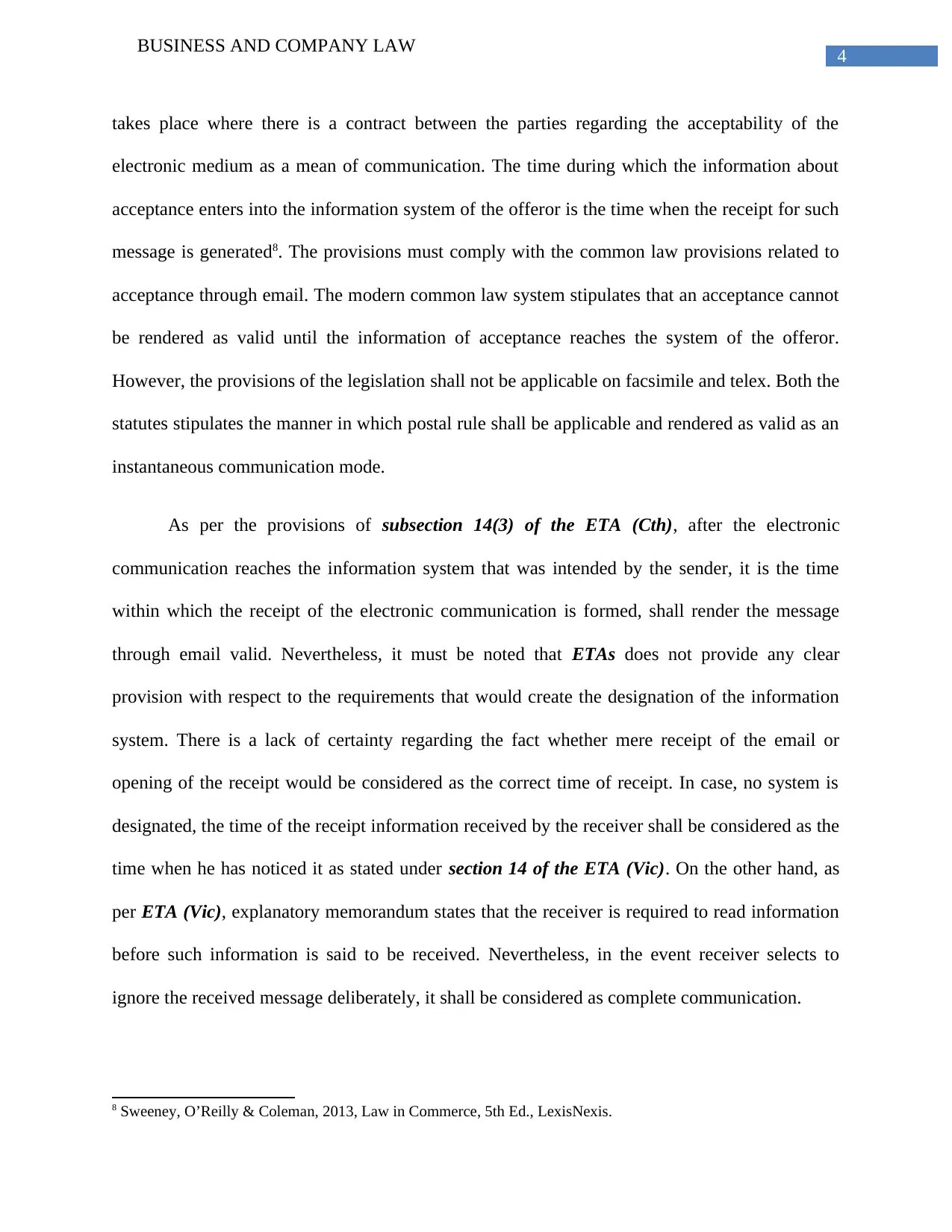
4
BUSINESS AND COMPANY LAW
takes place where there is a contract between the parties regarding the acceptability of the
electronic medium as a mean of communication. The time during which the information about
acceptance enters into the information system of the offeror is the time when the receipt for such
message is generated8. The provisions must comply with the common law provisions related to
acceptance through email. The modern common law system stipulates that an acceptance cannot
be rendered as valid until the information of acceptance reaches the system of the offeror.
However, the provisions of the legislation shall not be applicable on facsimile and telex. Both the
statutes stipulates the manner in which postal rule shall be applicable and rendered as valid as an
instantaneous communication mode.
As per the provisions of subsection 14(3) of the ETA (Cth), after the electronic
communication reaches the information system that was intended by the sender, it is the time
within which the receipt of the electronic communication is formed, shall render the message
through email valid. Nevertheless, it must be noted that ETAs does not provide any clear
provision with respect to the requirements that would create the designation of the information
system. There is a lack of certainty regarding the fact whether mere receipt of the email or
opening of the receipt would be considered as the correct time of receipt. In case, no system is
designated, the time of the receipt information received by the receiver shall be considered as the
time when he has noticed it as stated under section 14 of the ETA (Vic). On the other hand, as
per ETA (Vic), explanatory memorandum states that the receiver is required to read information
before such information is said to be received. Nevertheless, in the event receiver selects to
ignore the received message deliberately, it shall be considered as complete communication.
8 Sweeney, O’Reilly & Coleman, 2013, Law in Commerce, 5th Ed., LexisNexis.
BUSINESS AND COMPANY LAW
takes place where there is a contract between the parties regarding the acceptability of the
electronic medium as a mean of communication. The time during which the information about
acceptance enters into the information system of the offeror is the time when the receipt for such
message is generated8. The provisions must comply with the common law provisions related to
acceptance through email. The modern common law system stipulates that an acceptance cannot
be rendered as valid until the information of acceptance reaches the system of the offeror.
However, the provisions of the legislation shall not be applicable on facsimile and telex. Both the
statutes stipulates the manner in which postal rule shall be applicable and rendered as valid as an
instantaneous communication mode.
As per the provisions of subsection 14(3) of the ETA (Cth), after the electronic
communication reaches the information system that was intended by the sender, it is the time
within which the receipt of the electronic communication is formed, shall render the message
through email valid. Nevertheless, it must be noted that ETAs does not provide any clear
provision with respect to the requirements that would create the designation of the information
system. There is a lack of certainty regarding the fact whether mere receipt of the email or
opening of the receipt would be considered as the correct time of receipt. In case, no system is
designated, the time of the receipt information received by the receiver shall be considered as the
time when he has noticed it as stated under section 14 of the ETA (Vic). On the other hand, as
per ETA (Vic), explanatory memorandum states that the receiver is required to read information
before such information is said to be received. Nevertheless, in the event receiver selects to
ignore the received message deliberately, it shall be considered as complete communication.
8 Sweeney, O’Reilly & Coleman, 2013, Law in Commerce, 5th Ed., LexisNexis.
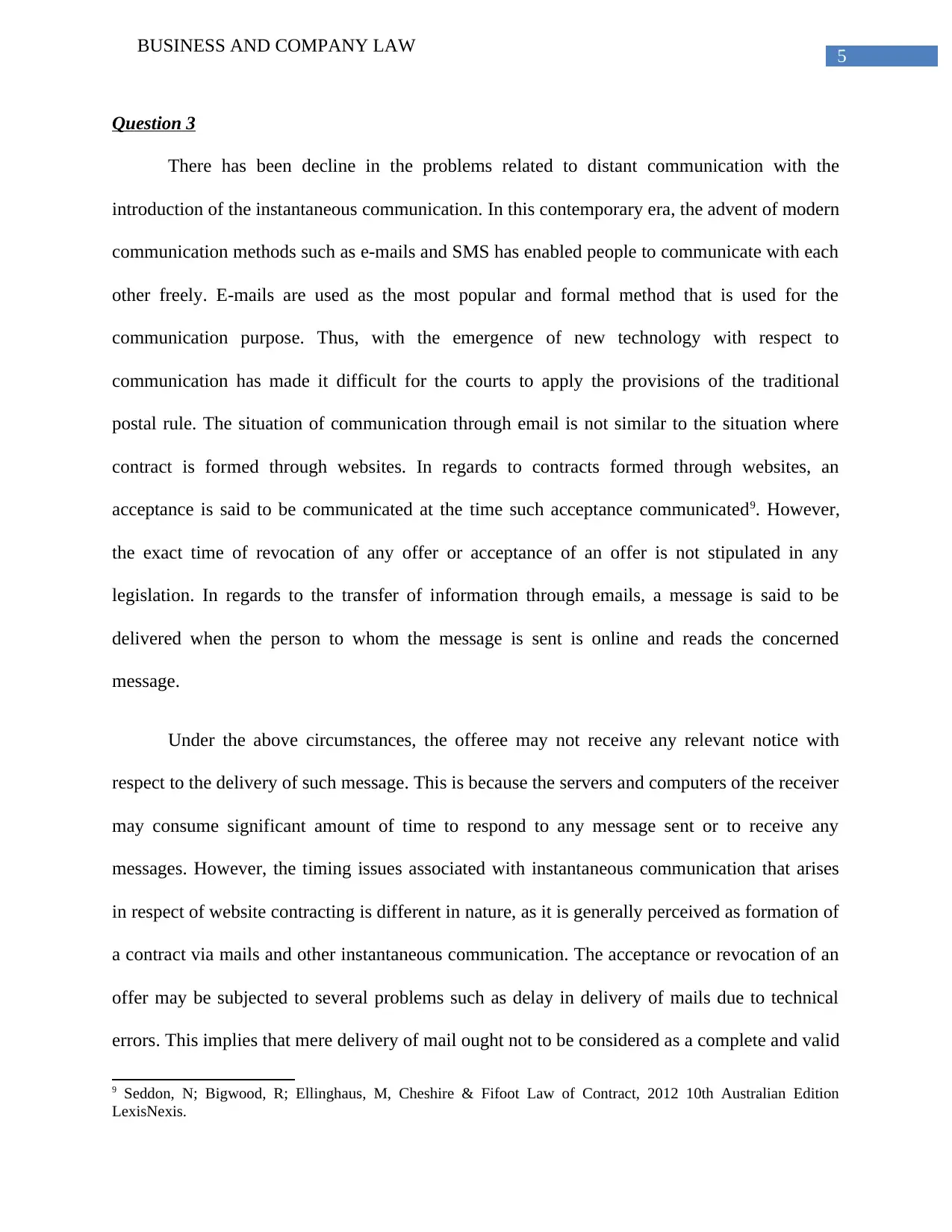
5
BUSINESS AND COMPANY LAW
Question 3
There has been decline in the problems related to distant communication with the
introduction of the instantaneous communication. In this contemporary era, the advent of modern
communication methods such as e-mails and SMS has enabled people to communicate with each
other freely. E-mails are used as the most popular and formal method that is used for the
communication purpose. Thus, with the emergence of new technology with respect to
communication has made it difficult for the courts to apply the provisions of the traditional
postal rule. The situation of communication through email is not similar to the situation where
contract is formed through websites. In regards to contracts formed through websites, an
acceptance is said to be communicated at the time such acceptance communicated9. However,
the exact time of revocation of any offer or acceptance of an offer is not stipulated in any
legislation. In regards to the transfer of information through emails, a message is said to be
delivered when the person to whom the message is sent is online and reads the concerned
message.
Under the above circumstances, the offeree may not receive any relevant notice with
respect to the delivery of such message. This is because the servers and computers of the receiver
may consume significant amount of time to respond to any message sent or to receive any
messages. However, the timing issues associated with instantaneous communication that arises
in respect of website contracting is different in nature, as it is generally perceived as formation of
a contract via mails and other instantaneous communication. The acceptance or revocation of an
offer may be subjected to several problems such as delay in delivery of mails due to technical
errors. This implies that mere delivery of mail ought not to be considered as a complete and valid
9 Seddon, N; Bigwood, R; Ellinghaus, M, Cheshire & Fifoot Law of Contract, 2012 10th Australian Edition
LexisNexis.
BUSINESS AND COMPANY LAW
Question 3
There has been decline in the problems related to distant communication with the
introduction of the instantaneous communication. In this contemporary era, the advent of modern
communication methods such as e-mails and SMS has enabled people to communicate with each
other freely. E-mails are used as the most popular and formal method that is used for the
communication purpose. Thus, with the emergence of new technology with respect to
communication has made it difficult for the courts to apply the provisions of the traditional
postal rule. The situation of communication through email is not similar to the situation where
contract is formed through websites. In regards to contracts formed through websites, an
acceptance is said to be communicated at the time such acceptance communicated9. However,
the exact time of revocation of any offer or acceptance of an offer is not stipulated in any
legislation. In regards to the transfer of information through emails, a message is said to be
delivered when the person to whom the message is sent is online and reads the concerned
message.
Under the above circumstances, the offeree may not receive any relevant notice with
respect to the delivery of such message. This is because the servers and computers of the receiver
may consume significant amount of time to respond to any message sent or to receive any
messages. However, the timing issues associated with instantaneous communication that arises
in respect of website contracting is different in nature, as it is generally perceived as formation of
a contract via mails and other instantaneous communication. The acceptance or revocation of an
offer may be subjected to several problems such as delay in delivery of mails due to technical
errors. This implies that mere delivery of mail ought not to be considered as a complete and valid
9 Seddon, N; Bigwood, R; Ellinghaus, M, Cheshire & Fifoot Law of Contract, 2012 10th Australian Edition
LexisNexis.
⊘ This is a preview!⊘
Do you want full access?
Subscribe today to unlock all pages.

Trusted by 1+ million students worldwide
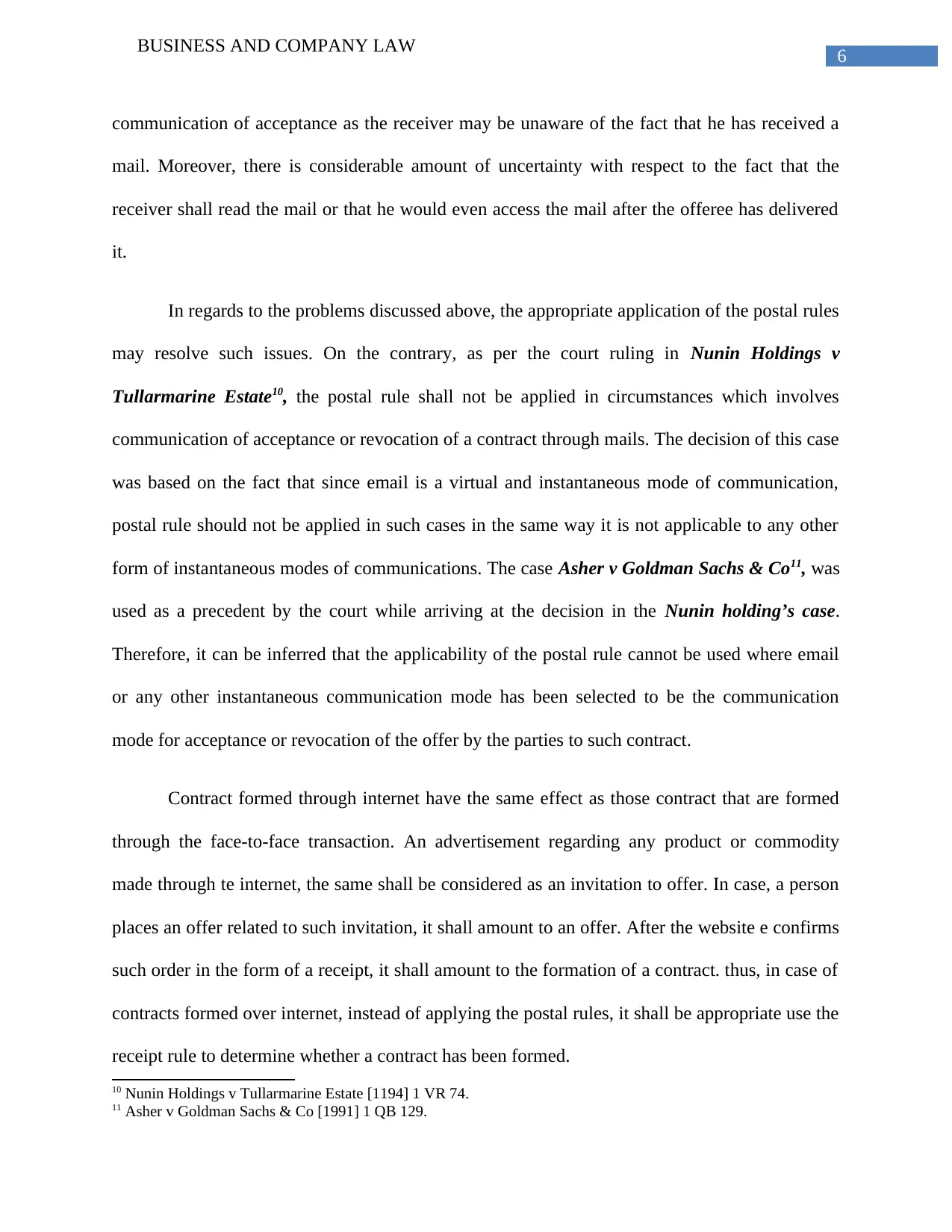
6
BUSINESS AND COMPANY LAW
communication of acceptance as the receiver may be unaware of the fact that he has received a
mail. Moreover, there is considerable amount of uncertainty with respect to the fact that the
receiver shall read the mail or that he would even access the mail after the offeree has delivered
it.
In regards to the problems discussed above, the appropriate application of the postal rules
may resolve such issues. On the contrary, as per the court ruling in Nunin Holdings v
Tullarmarine Estate10, the postal rule shall not be applied in circumstances which involves
communication of acceptance or revocation of a contract through mails. The decision of this case
was based on the fact that since email is a virtual and instantaneous mode of communication,
postal rule should not be applied in such cases in the same way it is not applicable to any other
form of instantaneous modes of communications. The case Asher v Goldman Sachs & Co11, was
used as a precedent by the court while arriving at the decision in the Nunin holding’s case.
Therefore, it can be inferred that the applicability of the postal rule cannot be used where email
or any other instantaneous communication mode has been selected to be the communication
mode for acceptance or revocation of the offer by the parties to such contract.
Contract formed through internet have the same effect as those contract that are formed
through the face-to-face transaction. An advertisement regarding any product or commodity
made through te internet, the same shall be considered as an invitation to offer. In case, a person
places an offer related to such invitation, it shall amount to an offer. After the website e confirms
such order in the form of a receipt, it shall amount to the formation of a contract. thus, in case of
contracts formed over internet, instead of applying the postal rules, it shall be appropriate use the
receipt rule to determine whether a contract has been formed.
10 Nunin Holdings v Tullarmarine Estate [1194] 1 VR 74.
11 Asher v Goldman Sachs & Co [1991] 1 QB 129.
BUSINESS AND COMPANY LAW
communication of acceptance as the receiver may be unaware of the fact that he has received a
mail. Moreover, there is considerable amount of uncertainty with respect to the fact that the
receiver shall read the mail or that he would even access the mail after the offeree has delivered
it.
In regards to the problems discussed above, the appropriate application of the postal rules
may resolve such issues. On the contrary, as per the court ruling in Nunin Holdings v
Tullarmarine Estate10, the postal rule shall not be applied in circumstances which involves
communication of acceptance or revocation of a contract through mails. The decision of this case
was based on the fact that since email is a virtual and instantaneous mode of communication,
postal rule should not be applied in such cases in the same way it is not applicable to any other
form of instantaneous modes of communications. The case Asher v Goldman Sachs & Co11, was
used as a precedent by the court while arriving at the decision in the Nunin holding’s case.
Therefore, it can be inferred that the applicability of the postal rule cannot be used where email
or any other instantaneous communication mode has been selected to be the communication
mode for acceptance or revocation of the offer by the parties to such contract.
Contract formed through internet have the same effect as those contract that are formed
through the face-to-face transaction. An advertisement regarding any product or commodity
made through te internet, the same shall be considered as an invitation to offer. In case, a person
places an offer related to such invitation, it shall amount to an offer. After the website e confirms
such order in the form of a receipt, it shall amount to the formation of a contract. thus, in case of
contracts formed over internet, instead of applying the postal rules, it shall be appropriate use the
receipt rule to determine whether a contract has been formed.
10 Nunin Holdings v Tullarmarine Estate [1194] 1 VR 74.
11 Asher v Goldman Sachs & Co [1991] 1 QB 129.
Paraphrase This Document
Need a fresh take? Get an instant paraphrase of this document with our AI Paraphraser
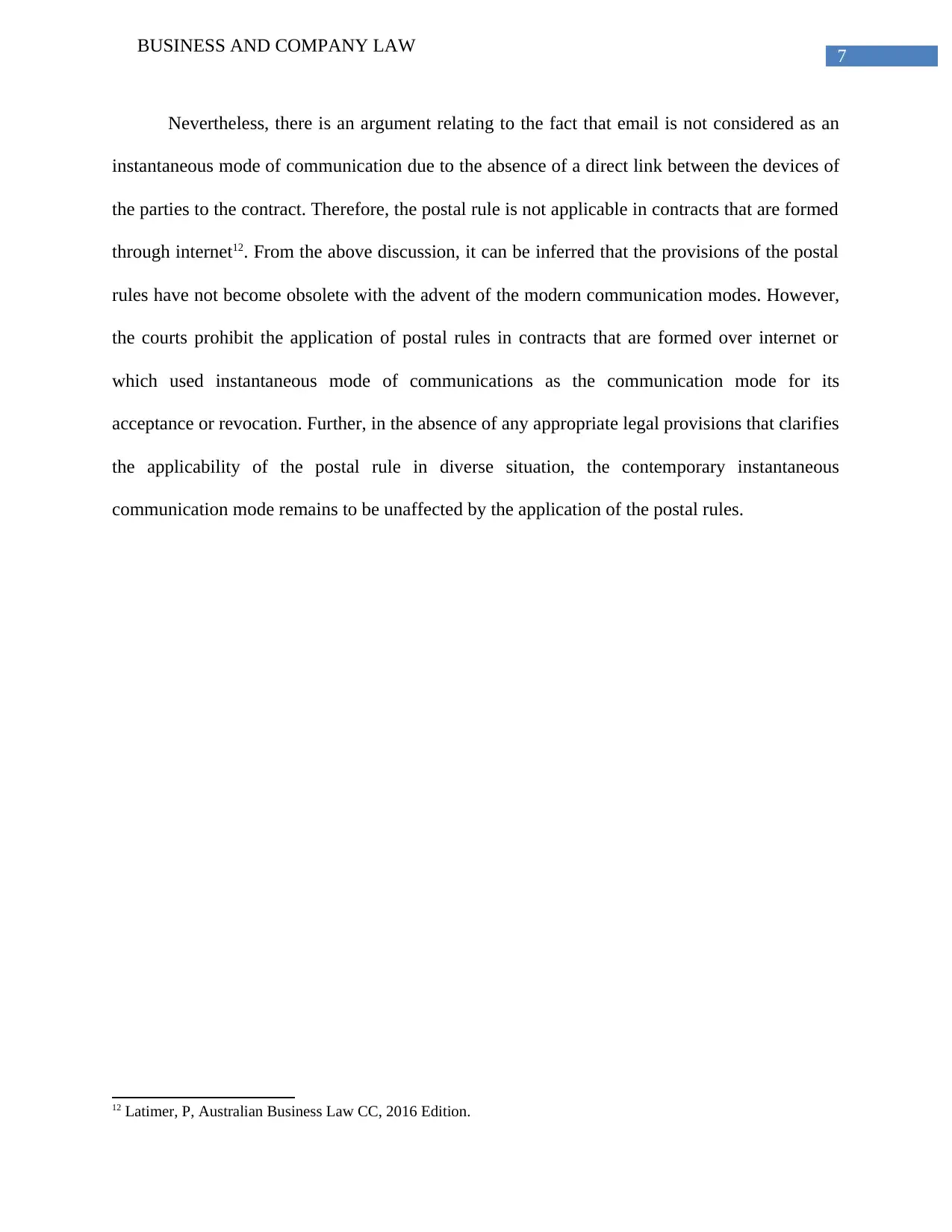
7
BUSINESS AND COMPANY LAW
Nevertheless, there is an argument relating to the fact that email is not considered as an
instantaneous mode of communication due to the absence of a direct link between the devices of
the parties to the contract. Therefore, the postal rule is not applicable in contracts that are formed
through internet12. From the above discussion, it can be inferred that the provisions of the postal
rules have not become obsolete with the advent of the modern communication modes. However,
the courts prohibit the application of postal rules in contracts that are formed over internet or
which used instantaneous mode of communications as the communication mode for its
acceptance or revocation. Further, in the absence of any appropriate legal provisions that clarifies
the applicability of the postal rule in diverse situation, the contemporary instantaneous
communication mode remains to be unaffected by the application of the postal rules.
12 Latimer, P, Australian Business Law CC, 2016 Edition.
BUSINESS AND COMPANY LAW
Nevertheless, there is an argument relating to the fact that email is not considered as an
instantaneous mode of communication due to the absence of a direct link between the devices of
the parties to the contract. Therefore, the postal rule is not applicable in contracts that are formed
through internet12. From the above discussion, it can be inferred that the provisions of the postal
rules have not become obsolete with the advent of the modern communication modes. However,
the courts prohibit the application of postal rules in contracts that are formed over internet or
which used instantaneous mode of communications as the communication mode for its
acceptance or revocation. Further, in the absence of any appropriate legal provisions that clarifies
the applicability of the postal rule in diverse situation, the contemporary instantaneous
communication mode remains to be unaffected by the application of the postal rules.
12 Latimer, P, Australian Business Law CC, 2016 Edition.
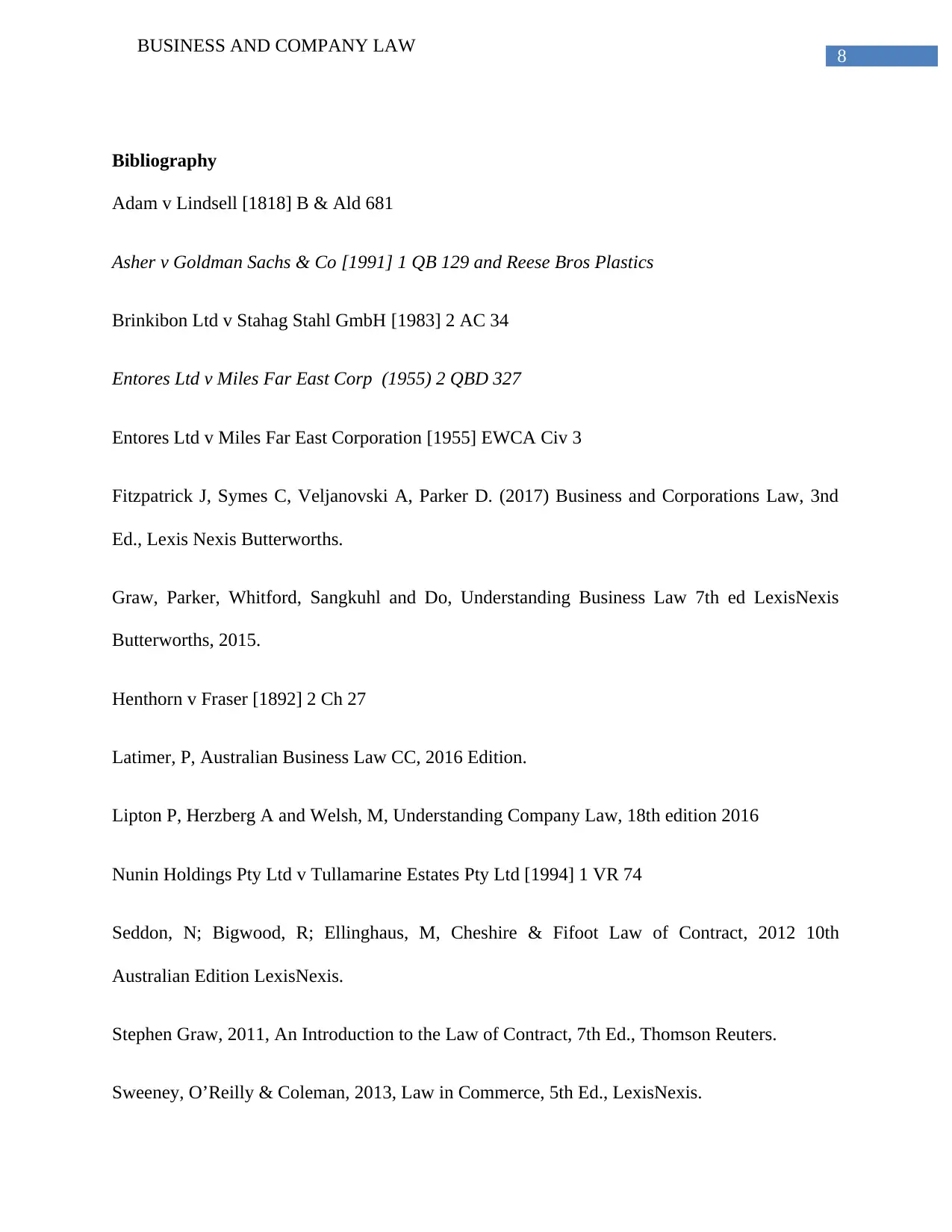
8
BUSINESS AND COMPANY LAW
Bibliography
Adam v Lindsell [1818] B & Ald 681
Asher v Goldman Sachs & Co [1991] 1 QB 129 and Reese Bros Plastics
Brinkibon Ltd v Stahag Stahl GmbH [1983] 2 AC 34
Entores Ltd v Miles Far East Corp (1955) 2 QBD 327
Entores Ltd v Miles Far East Corporation [1955] EWCA Civ 3
Fitzpatrick J, Symes C, Veljanovski A, Parker D. (2017) Business and Corporations Law, 3nd
Ed., Lexis Nexis Butterworths.
Graw, Parker, Whitford, Sangkuhl and Do, Understanding Business Law 7th ed LexisNexis
Butterworths, 2015.
Henthorn v Fraser [1892] 2 Ch 27
Latimer, P, Australian Business Law CC, 2016 Edition.
Lipton P, Herzberg A and Welsh, M, Understanding Company Law, 18th edition 2016
Nunin Holdings Pty Ltd v Tullamarine Estates Pty Ltd [1994] 1 VR 74
Seddon, N; Bigwood, R; Ellinghaus, M, Cheshire & Fifoot Law of Contract, 2012 10th
Australian Edition LexisNexis.
Stephen Graw, 2011, An Introduction to the Law of Contract, 7th Ed., Thomson Reuters.
Sweeney, O’Reilly & Coleman, 2013, Law in Commerce, 5th Ed., LexisNexis.
BUSINESS AND COMPANY LAW
Bibliography
Adam v Lindsell [1818] B & Ald 681
Asher v Goldman Sachs & Co [1991] 1 QB 129 and Reese Bros Plastics
Brinkibon Ltd v Stahag Stahl GmbH [1983] 2 AC 34
Entores Ltd v Miles Far East Corp (1955) 2 QBD 327
Entores Ltd v Miles Far East Corporation [1955] EWCA Civ 3
Fitzpatrick J, Symes C, Veljanovski A, Parker D. (2017) Business and Corporations Law, 3nd
Ed., Lexis Nexis Butterworths.
Graw, Parker, Whitford, Sangkuhl and Do, Understanding Business Law 7th ed LexisNexis
Butterworths, 2015.
Henthorn v Fraser [1892] 2 Ch 27
Latimer, P, Australian Business Law CC, 2016 Edition.
Lipton P, Herzberg A and Welsh, M, Understanding Company Law, 18th edition 2016
Nunin Holdings Pty Ltd v Tullamarine Estates Pty Ltd [1994] 1 VR 74
Seddon, N; Bigwood, R; Ellinghaus, M, Cheshire & Fifoot Law of Contract, 2012 10th
Australian Edition LexisNexis.
Stephen Graw, 2011, An Introduction to the Law of Contract, 7th Ed., Thomson Reuters.
Sweeney, O’Reilly & Coleman, 2013, Law in Commerce, 5th Ed., LexisNexis.
⊘ This is a preview!⊘
Do you want full access?
Subscribe today to unlock all pages.

Trusted by 1+ million students worldwide

9
BUSINESS AND COMPANY LAW
Thomson Reuters. Harris, J. Hargovan, A. Adams, M. Australian Corporate Law LexisNexis
Butterworths 5th edition, 2015.
Vermeesch,R B, Lindgren, K E, Business Law of Australia Butterworths, 12th Edition, 2011.
BUSINESS AND COMPANY LAW
Thomson Reuters. Harris, J. Hargovan, A. Adams, M. Australian Corporate Law LexisNexis
Butterworths 5th edition, 2015.
Vermeesch,R B, Lindgren, K E, Business Law of Australia Butterworths, 12th Edition, 2011.
1 out of 10
Related Documents
Your All-in-One AI-Powered Toolkit for Academic Success.
+13062052269
info@desklib.com
Available 24*7 on WhatsApp / Email
![[object Object]](/_next/static/media/star-bottom.7253800d.svg)
Unlock your academic potential
Copyright © 2020–2025 A2Z Services. All Rights Reserved. Developed and managed by ZUCOL.



